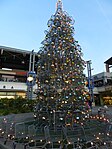Temescal Creek (Northern California)

Temescal Creek (Temescal, Spanish for "sweat lodge") is one of the principal watercourses in the city of Oakland, California, United States. The word "temescal" is a Spanish term derived from temescalli, which means "sweat house" in the Nahuatl language of Mexico. The name was given to the creek when it became part of the Peralta's Rancho San Antonio. It is surmised that the Peraltas or perhaps one of their ranch hands (vaqueros) had seen local indigenous (Ohlone) structures along the creek similar to those in other parts of New Spain which were called temescalli. Three forks begin in the Berkeley Hills in the northeastern section of Oakland (also referred to as the Oakland hills south of the Caldecott Tunnel), part of the Pacific Coast Ranges, coming together in the Temescal district of Oakland, then flowing westerly across Oakland and Emeryville to San Francisco Bay. The north fork of Temescal Creek was renamed "Harwood's Creek" in the mid 19th century after an early claimant to grazing lands in the canyon above the Claremont neighborhood, retired sea captain and Oakland wharfinger William Harwood. It was renamed yet again "Claremont Creek" in the early 20th century after a residential development in the same vicinity, today's Claremont district. The middle fork flows through Temescal Canyon mostly in underground culverts, beneath the Grove Shafter Freeway starting near the Caldecott Tunnel and underneath the interchange with State Route 13. It joins the south fork at Lake Temescal. Before the Caldecott tunnel project (1934–37), this fork entered the lake via a prominent inlet that was traversed by a trestle bridge of the Sacramento Northern Railroad. The inlet was filled in and the trestle replaced by a large concrete embankment which exists to this day. The south fork begins in the northern section of Oakland's Montclair district, flowing southwest out of a canyon in the hills alongside Thornhill Road, then turning abruptly northwestward in the linear valley formed by the Hayward Fault. It then flows into Lake Temescal, a natural sag pond which was dammed in the 19th century to increase its capacity for use as a reservoir. Lake Temescal is now a public park. The creek continues out of the northernmost corner of Lake Temescal into another underground culvert. The tunnel follows the Grove Shafter Freeway and briefly re-emerges next to Saint Albert's Priory next to Presley Way and Miles Avenue. It continues westerly around the end of the shutter ridge in the Rockridge district of Oakland, where it joins the north fork (Claremont Creek) at approximately the intersection of Forrest Street and Miles Avenue. A small section of above-ground creek exists as the Rockridge-Temescal Greenbelt parallel to Claremont Avenue between the Grove Shafter Freeway and Telegraph Avenue. A pumping station at the top of the greenbelt diverts water from the tunnel and pumps it up to the surface creek. After Telegraph Avenue the tunnel continues east underneath the Temescal Community Garden and Temescal Creek Parks, then follows 53rd Street through Emeryville to its mouth at Bay Street.
Excerpt from the Wikipedia article Temescal Creek (Northern California) (License: CC BY-SA 3.0, Authors, Images).Temescal Creek (Northern California)
Eastshore Freeway,
Geographical coordinates (GPS) Address Nearby Places Show on map
Geographical coordinates (GPS)
| Latitude | Longitude |
|---|---|
| N 37.833888888889 ° | E -122.295 ° |
Address
Eastshore Freeway
Eastshore Freeway
94608
California, United States
Open on Google Maps








